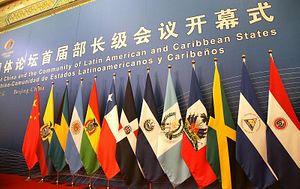Regional tension over the management of the Inter-American Development Bank (IDB) could increase Latin American lending from China. Although China has decreased its loans to Latin America in recent years, the politicization of the IDB presidency and China’s desire for post-COVID-19 diplomacy present an ideal opportunity for deepened reengagement. After the IDB’s ideological shift and economic damage from COVID-19, Latin American countries may also gravitate to Chinese loans to maintain funding while preserving political autonomy. These symmetrical interests should predict enhanced Chinese-Latin American development finance ties in the near future. Yet due to lingering concerns of debt trap diplomacy and growing Chinese domestic debt, deepened Chinese-Latin American collaboration is far from certain. Ultimately, Latin American countries seek immediate, apolitical, and well-financed development resources that neither the IDB nor Chinese alternatives can fully assure.
This September, Mauricio Claver-Carone assumed the IDB presidency amidst vocal Latin American dissent. Initial opposition arose because the role has traditionally been filled by a Latin American candidate, which Claver-Carone (a U.S. citizen) is not. Beyond ignoring an implicit custom, Claver-Carone drew further criticism for his views on Cuba and Venezuela, as well as his condemnation of countries with other candidates for the IDB presidency. Barely a month into the job, Claver-Carone has further alienated regional partners by selecting senior officials chiefly from countries that supported him. Claver-Carone’s ascension and his policy preferences were widely interpreted by regional countries as pressure from the United States to reduce Latin American economic reliance on China.
Prior to the IDB controversy, Chinese loan quantities in Latin America were in fact decreasing. Historically, Chinese development loans to Latin America have been funneled through the China Development Bank (CDB) and the Export-Import Bank of China (China Exim). Lending figures of these banks reached a 10-year low in 2019, and a prior 2020 analysis of Chinese loans commented that they had “all but dried up.” Nonetheless, there exists potential for expanded lending should China be interested in reasserting regional influence. The Industrial and Commercial Bank of China (ICBC) also has a Latin American presence, while China has previously financed regional funds such as the China-LAC Industrial Cooperation Investment Fund, the China-LAC Cooperation Fund, and the Special Loan Program for China-Latin America Infrastructure.
These diversified sources of Chinese multilateral loans are coupled with Chinese foreign direct investment, which totaled $12.8 billion last year alone. And although Chinese lending has dwindled, as Margaret Myers of Inter-American Dialogue pointed out, it was “once a top creditor to Latin American governments, at times exceeding sovereign lending from the Inter-American Development Bank and World Bank.” Such context suggests that when China deems it opportune, the country has the resources to draw Latin American governments’ interest away from the IDB and toward China’s own initiatives.
Now may be an opportune moment for Chinese influence. In the aftermath of a politicized IDB election and COVID-19’s economic impact across Latin America, increased lending would address two of China’s foreign policy aims. First, the country can burnish its image after being associated with the source of COVID-19. China recently announced a $1 billion loan program for Latin American and Caribbean countries to access China’s prospective COVID-19 vaccine. In line with a long-standing foreign policy mandate to distinguish itself from the United States, China can use momentum against Claver-Carone to advertise its diplomatic “partnerships of equals” and consolidate its influence in Latin America. The chief potential impediment to increasing strategic spending is China’s own debt levels, which have grown in recent years.
Prior to the IDB controversy, Latin American countries regarded Chinese lending with caution. Such loans often came with clauses requiring the use of Chinese companies or equipment, which diminished its appeal. At the macro level, Chinese lending has also been caught up in several controversies: whether China demands partner countries to align their foreign policies with China’s before receiving Chinese loans, and whether or not China uses unsustainable loan deals as part of a long-term plan to “attain economic assets or political leverage”: a practice coined as debt trap diplomacy.
Despite the drawbacks of negotiating with China, in light of the IDB politicization, Latin American governments may gravitate toward collaboration. It may become harder to evaluate the differences between a U.S.-dominated IDB and Chinese debt trap diplomacy, since both may require adherence to certain policy values. If Latin America’s two major lending options both have political overtones, Latin American countries may pick Chinese loans. After all, in past years Chinese loans have surpassed IDB loan amounts, an important consideration for countries feeling COVID-19’s economic damage. Furthermore, even if Chinese and IDB loans both require policy alignment, Chinese loans are at least framed with the language of collaboration over browbeating – a face-saving gesture for countries that prize autonomy.
Theoretical expectations suggest that Chinese-Latin American development funding will grow in the coming years. Yet ultimately, this will be determined by the choices of Latin American governments, Chinese lending authorities, and the IDB. Lingering concerns of debt trap diplomacy may dilute Latin American interest, while growing domestic debt may slow Chinese interest. Meanwhile, there is still time for IDB leadership to express a less partisan lending philosophy. If senior officials realize they have undermined the IDB’s chief selling point of nonpartisanship and have created incentives for their undesired outcome of closer China-Latin America collaboration, they may yet course correct. As of now, however, Latin American countries seek immediate, apolitical, and well-financed development resources – something offered by neither the IDB nor Chinese alternatives.
Isabel Bernhard (@isabernhd) is an MSc candidate in Latin American Studies at the University of Oxford and a graduate of Harvard College.

































